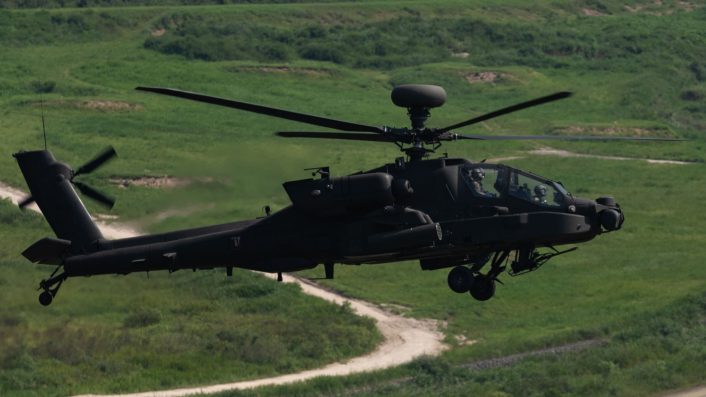South Korea will shift towards cheaper attack drones to cover the same tank busting roles, consistent with evolving trends in modern warfare.
South Korea has now given an official imprimatur to its plans to not proceed with the purchase of 36 additional AH-64E Apache attack helicopters after reports of the rethink pushed by the country’s lawmakers emerged in October 2024. Chosun and Yonhap reported that a supplementary budget pushed by the opposition People’s Power Party’s (PPP) lawmaker Rep. Yoo Yong-won passed in the National Assembly on Jul. 4, 2025, allocating merely 300 million Won from the initial 10 billion Won ($7.3 million) budgeted for the acquisition.
The Korea Times said that the second phase of the procurement of the additional Apaches by 2028 for over 3 trillion won ($2.2 billion) has now been “effectively scrapped.” In its latest report, Chosun further stated that “with the latest round of cuts in the supplementary budget, the likelihood of the project being canceled has significantly increased.”
In October 2024, Chosun said the cost per airframe for the first phase of the AH-64E Apache purchase – which provided the RoKA (Republic of Korea Army) with 36 airframes delivered between 2016 and 2017 – was 44.1 billion won ($31 million). However, the expected price for the second phase “skyrocketed” to 73.3 billion won-a-piece ($52 million), with the “possibility that it will increase further in the future.”
Additionally, in October 2024, South Korean officials questioned the wisdom of the procurement of the additional 36 Apaches consuming “70% of the Army’s annual budget” (approximately 6.5 trillion won or $4.68 billion).
BREAKING:
South Korea scraps its plans to buy a second batch of 36 additional Apache attack helicopters from the U.S. for USD 7 billion.
South Korea says it will spend the money on drones instead
🇰🇷🇺🇸 pic.twitter.com/i2UsJaJBNn
– Visegrád 24 (@Visegrad24) July 7, 2025
Russia-Ukraine war informed South Korea’s Apache plans
Late in August 2024, the U.S. State Department approved the FMS (Foreign Military Sale) deal for the additional 36 attack helicopters. This also included 456 AGM-114R2 Hellfire and 152 AGM-179A JAGM (Joint Air-to-Ground Missiles) missiles, along with Electronic Warfare (EW), defensive, target acquisition and communication systems.
Beside the high-cost implications, the rethink in South Korea was also driven by the vulnerability of attack helicopters in modern warfare, as seen in the high number of Russian Kamov Ka-52 Alligator attack helicopters lost to Man-Portable Air Defense Systems (MANPADS) in Ukraine. Like last year, the latest reports from South Korea stress on how Seoul will be “shifting […] towards” the cheaper but equally effective attack drones substitutes for the same tank and bunker busting roles, consistent with “evolving trends in modern warfare.”
‘Effectively scrapped’
Welcoming the decision, Yu cited “the increasing vulnerability of helicopters to low-cost missile and drone attacks […] on the battlefield in Ukraine,” TKT reported.
“The reconsideration of Apache procurement is a positive step. We need to invest in drones and other cutting-edge systems,” Yu further told TKT. Yu also mentioned how the U.S. Army’s shift to drones like the Gray Eagle justifies a “comprehensive reexamination” of South Korea’s own plan to expand its Apache fleet.
🇺🇸🇰🇷 From left to right, a U.S. Marine Corps MV-22B Osprey, UH-1Y Venom and AH-1Z Viper, and a U.S. Army AH-64E Apache are parked at Kunsan Air Base, South Korea, Sept. 4, 2024, during exercise Ssang Yong 24.
(📸/U.S. Marine Corps photo by Capt. Staci Morris) pic.twitter.com/rRqwBzYzlL
— Guy Plopsky (@GuyPlopsky) July 6, 2025
The Apaches’ procurement was approved under the previous President Moon Jae-in’s administration’s “New Offensive Operational Plan” spearheaded by former defense minister Song Young-moo, which planned “to end the war in two weeks” by “deploying special forces to Pyongyang using helicopters.” However, the reconciliation and inter-Korean dialogue pushed by Moon Jae-in himself led to its unofficial demise.
Are attack helicopters really obsolete?
TKT and Chosun have published conflicting claims about the outcome of a May meeting of the Joint Chiefs of Staff on whether the second phase of the AH-64E Apache acquisition was approved. However, both publications said it was the performance of attack helicopters in Ukraine driving the rethink in Seoul.
The reports interpreted the heavy losses of Russian helicopters to MANPADS as a “cautionary signal.” Additionally, the U.S. Army cancelling its own Future Attack Reconnaissance Aircraft (FARA) and Japan and Australia undertaking “similar reviews” were also mentioned by TKT.
The first of Canberra’s 29 AH-64E Apaches had entered the final assembly at Boeing facility in Mesa, Arizona in Mar. 2025as the Australian Army also looks to dispose its older 22 Eurocopter (now Airbus) Tiger attack helicopters. “Drones and smart systems are redefining modern battlefields,” Yu said, advising against “clinging to expensive legacy platforms,” according to TKT.

However, as we analyzed here at The Aviationistmore than the vulnerability of attack helicopters, it is their foreign origin that imposes life-cycle and upgrade constraints during conventional wars. This was reflected in U.S. and NATO allies like the U.K. preparing their Apaches for the land war against Russian armor in the European theater, and Russia’s Ka-52s also contributing to thwarting Ukraine’s counter-offensive in the summer of 2023.
Ukraine itself was seeking the AH-1Z Viper attack helicopter at one point to maximize its benefits from the Kursk offensive. China meanwhile appears to be considering its Z-10 attack helicopter even for maritime warfare, besides a traditional overhead gunship role in a Taiwan invasion.
Lastly, loitering munitions claimed to be able to substitute attack helicopters, are themselves being tested to be controlled from the rotary wing aircraft for MUM-T (Manned-Unmanned Teaming).
blockquote class=”twitter-tweet”>
Reportedly photos of Russian Ka-52 helicopter. Allegedly shot down by Wagner near the village of Talovaya, Voronezh region. pic.twitter.com/8mEoJxm9Ug
– Special Kherson Cat 🐈🇺🇦 (@Bayraktar_1Love) June 24, 2023
The benefits of heavy, persistent Close Air Support (CAS) fire with guided/unguided rockets, tank-busting missiles and machine guns for anti-infantry roles offered by helicopter gunships is undeniable in the land war that would erupt in the Korean Peninsula.
Indigenous LAH might be a better option
Seoul’s rethink on the AH-64E Apache program is driven more by the cost and logistical implications rather than the relevance of the system, particularly when we consider its domestic aerospace major Korea Aerospace Industries (KAI) has developed the Light Armed Helicopter (LAH).
KAI delivered the first two LAHs to the RoKA on Dec. 26, 2024m, according to Janes. The platform was also designated Miron (LAH-1) at the Korea Army International Defense Industry Exhibition (KADEX) in October 2024.
South #Korea‘s attack #helicopters in the #rain. @Buingdefense Ah-64e #Apache and Korea Aerospace Industries #KAI Light Attack Helicopter #LAH. pic.twitter.com/GeLq7tlHXd
— Kelvin Wong (@PENxSWORD) October 29, 2024
The five tonne-class helicopter based on the Airbus H155 will replace the RoKA’s fleet of MD-500 Defender and Bell AH-1S Cobra attack helicopters. Seoul’s Defense Acquisition Programme Administration (DAPA) said in a statement on Dec. 27, 2024: “In the future, Mirons will be operated as a core force for future aviation operations of the army.”
Source link
[aviation news]
Share this content:

